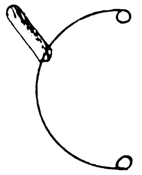Additional Experiment, [27 September 1750]
Additional Experiment
Copy: American Academy of Arts and Sciences5
[September 27, 1750]6
Additional Experiment proving that the Leyden Bottle has no more Electrical Fire in it, when charg’d, than before; nor less when discharg’d. That in Discharging, the Fire does not issue from the Wire and Coating7 at the same Time, as some have thought; but that the Coating always receives what is discharg’d by the Wire, or an equal Quantity: the outer Surface being always in a negative State of Electricity, when the inner Surface is in a positive State.
Place a thick Plate of Glass under the rubbing Cushion, to cut off the Communication of Electrical Fire from the Floor to the Cushion: Then if there be no fine Points or hairy Threads Sticking out from the Cushion or from the Parts of the Machine opposite to the Cushion, of which you must be careful, you can get but a few Sparks from the Prime Conductor; which are all the Cushion will part with.
Hang a Vial then on the Prime Conductor, and it will not charge, tho’ you hold it by the Coating. But
Form a Communication by a Chain from the Coating to the Cushion, and the Phial will charge.
For the Globe then draws the Electrical8 Fire out of the Outside Surface of the Phial and forces it thro’ the Prime Conductor and Wire of the Phial into the inside Surface.
Thus the Bottle is charg’d with it’s own Fire, no other being to be had, while the Glass Plate is under the Cushion.
Hang two Cork Balls by Flaxen Threads to the Prime Conductor, then touch the Coating of the Bottle, and they will be electrified, and recede from each other.
For just as much Fire as you give the Coating, so much is discharg’d thro’ the Wire upon the Prime Conductor, whence the Cork Balls receive an Electrical Atmosphere. But
Take a Wire bent in this Form9 with a Wax Handle to hold it by, and apply one End of this Wire to the Coating and the other at the Same Time to the Prime Conductor; the Vial will be discharged. And if the Balls are not electrified before the Discharge, neither will they appear to be so after the Discharge, for they will not repel each other.
And if the Balls are not electrified before the Discharge, neither will they appear to be so after the Discharge, for they will not repel each other.
Now if the Fire, discharg’d from the inside Surface of the Bottle, thro’ its Wire, remain’d on the prime Conductor, the Balls would be electrified and recede from each other.
If the Vial really exploded at both Ends and discharged Fire from both Coating and Wire, the Balls would be more electrified and recede farther: for none of the Fire can escape, the Wax Handle preventing.
But if the Fire with which the inside Surface is surcharg’d be so much precisely as is wanted by the outside Surface, it will pass round thro’ the Wire fixt to the Wax Handle, restore the Equilibrium in the Glass and make no Alteration in the State of the Prime Conductor.
Accordingly we find that if the Prime Conductor be electrified, and the Cork Balls in a State of Repellancy, before the Bottle is discharg’d,1 they continue so afterwards: If not, they are not electrified by that Discharge.
To P. Collinson Esq. F.R.S. London2
5. This paper was included in the Bowdoin MS (see above, III, 116–18); it is not numbered there or in any printed edition of Exper. and Obser., but in all cases follows directly the “Opinions and Conjectures” of July 29, 1750.
6. This experiment was completed well before Oct. 25, when it was copied for James Bowdoin. It is probably BF’s “last piece on Electricity,” which he told Collinson, Feb. 4, 1751 (see below, p. 112) he had sent “by Ouchterlony.” Capt. Patrick Ouchterlony last cleared Philadelphia for London in late September, according to Pa. Gaz., Sept. 27, 1750. See also below, p. 114. For this reason the date of Sept. 27, 1750, has been conjecturally assigned to this piece.
7. In all printed editions: “and the Coating.”
8. In 1769 and 1774 editions: “electric.”
9. In all printed editions: “Take a wire bent in the form of a C, with a stick of wax fixed to the outside of the curve.” The illustration does not appear in the printed texts, as it does in the MS.
1. In 1751, 1754, and 1760 editions: printed incorrectly as “charged.” The error was noted in “Additional Errata” in the 1753 reprinting of the first edition and was corrected in the 1769 and 1774 editions.
2. The address is in BF’s hand; it does not appear in the printed editions.

![University of Virginia Press [link will open in a new window] University of Virginia Press](/lib/media/rotunda-white-on-blue.png)
